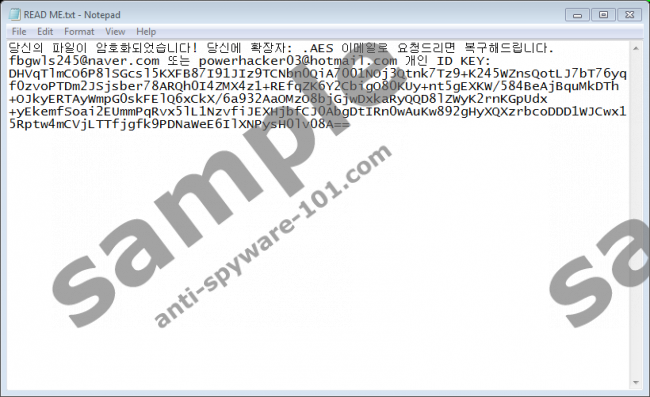What is RansomAES Ransomware?
Windows users who live in Korea need to be extremely cautious about RansomAES Ransomware. If it finds its way in, it can silently encrypt the most personal and important files, and the worst part is that chances of full recovery are very slim. Unfortunately, that is not the illusion that cyber criminals behind this malware create. They use several messages to make victims believe that they can recover data for a certain free, i.e., a ransom. Although no specific numbers are available at this moment, it is likely that the sum of the ransom is quite substantial. In any case, paying it would not be wise because cyber criminals do not care about the files that their malware corrupts, and so helping victims recover it is not on their agenda. Of course, it is up to you whether or not you want to take the risk. If you do, let us known in the comments section how things go for you. You should also share any information about free decryptors. At the time of analysis, the research team that was working on deleting RansomAES Ransomware did not find a free decryptor that would work in this case.

How does RansomAES Ransomware work?
RansomAES Ransomware works in the same way as KoreanLocker Ransomware, Korean AdamLocker Ransomware, and most other file-encryptors. It slithers in, finds personal files, and uses an encryption key to corrupt them. The encryption key is likely to be downloaded silently as soon as the infection is executed. Once in place, it is used to encrypt .doc, .ppt, .txt, .jpg .rar, .zip, .mp3, .PDF, .log, .7zip, and even .exe files in the %USERPROFILE% directory. That means that besides corrupting personal photos, music files, or documents, RansomAES Ransomware also can mess with the software you have downloaded, and, possibly, even paid for. Of course, downloading these files anew should not be difficult, but that is not the same with personal files. Do you regularly back up personal files? If you do, and you know that the corrupted files (they all have the “.RansomAES” extension) have backup copies, you can remove the original files without any hesitation. Just note that your files will not magically decrypt when you delete the ransomware. That being said, eliminating this threat is crucial, and you must take care of that as soon as you possibly can.
Were you introduced to the messages created by RansomAES Ransomware? One of them is displayed via a window that pops up on the screen without the “close” option. You can close it by tapping keys Alt and F4 on your keyboard at the same time. This ransom note introduces you to fbgwls245@naver.com and powerhacker03@hotmail.com email addresses, and you are supposed to send an ID key to them to get further instructions. These instructions should explain how to pay a ransom in Bitcoins because the payment is mentioned. RansomAES Ransomware also creates a file named “READ ME.txt.” The message inside mentions the email addresses as well. So, should you email cyber crooks? You should not unless you want them to learn your own address, or if you are seriously interested in paying the ransom. As mentioned previously, we cannot tell you what to do when it comes to this because the matter involves serious risk. What we can tell you is that you need to remove the ransomware ASAP.
How to delete RansomAES Ransomware
Have you figured out what you want to do? Will you rely on backups to access your personal files? Will you accept the loss? Or will you pay the ransom that is requested by RansomAES Ransomware? The choice is yours, but whatever you do, you need to delete this malicious threat. If you have experience and you are tech-savvy, removing RansomAES Ransomware manually should not be too complicated. Less experienced users can rely on legitimate anti-malware software to automatically eliminate all infections, and we have to consider the possibility that others exist. Even if you are perfectly capable of erasing the infection manually, you still need the help of anti-malware software to ensure that your operating system is protected in the future. Another measure of security should be to back up personal data if that is something you have not taken care of already.
Removal Guide
- Find the .exe file of the malicious ransomware, right-click it, and choose Delete.
- Right-click and Delete the READ ME.txt file. If copies exist, erase them as well.
- Use a legitimate malware scanner to check if your operating system is clean and safe to use.
100% FREE spyware scan and
tested removal of RansomAES Ransomware*





0 Comments.